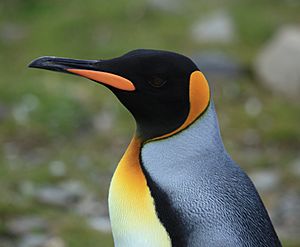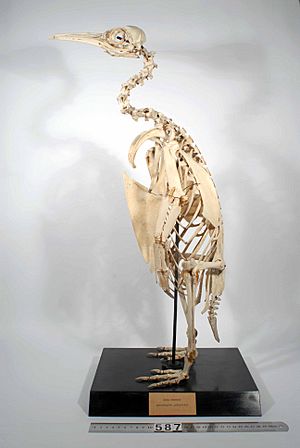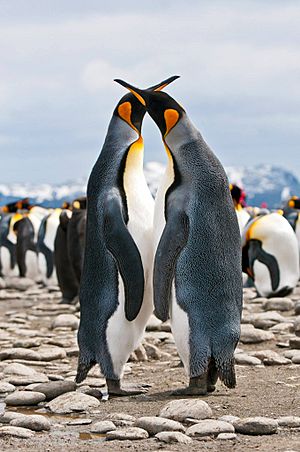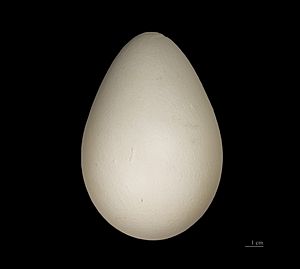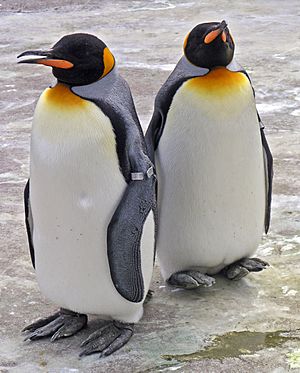King penguin facts for kids
Quick facts for kids King penguin |
|
|---|---|
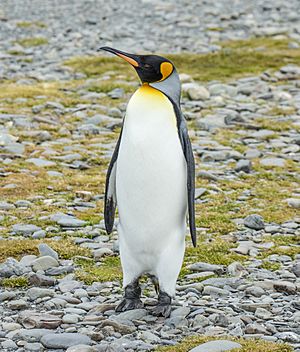 |
|
| King penguin Fortuna Bay, South Georgia | |
| Conservation status | |
| Scientific classification | |
| Genus: |
Aptenodytes
|
| Species: |
patagonicus
|
|
.
|
|
| Red: Aptenodytes patagonicus patagonicus Yellow: Aptenodytes patagonicus halli |
|
The king penguin (Aptenodytes patagonicus) is the second largest type of penguin. It looks a bit like the emperor penguin but is smaller. There are two main groups, called subspecies: A. p. patagonicus and A. p. halli. You can find patagonicus in the South Atlantic. The halli group lives in the South Indian Ocean, including places like the Kerguelen Islands and Macquarie Island.
King penguins mostly eat lanternfish, squid, and krill. When they hunt for food, they often dive deeper than 100 meters (330 feet). Some have even been seen diving deeper than 300 meters (980 feet)! Animals that hunt king penguins include giant petrels, skuas, leopard seals, and orcas.
King penguins make their homes and raise their young on islands near Antarctica. These are called Subantarctic islands, like South Georgia and other mild islands in that area.
Contents
What King Penguins Look Like
King penguins stand about 70 to 100 centimeters (28 to 39 inches) tall. They weigh between 9.3 and 18 kilograms (20.5 to 40 pounds). Male king penguins are usually a bit bigger than females. You can also tell them apart by their calls. For example, on Marion Island, males weigh about 12.4 kg (27.3 lb) and females about 11.1 kg (24.5 lb). King penguins are about 25% shorter and weigh about one-third less than the emperor penguin.
At first glance, king penguins look very much like their close relatives, the emperor penguins. Both have a bright patch on their cheeks and yellow-orange feathers on their upper chest. However, the king penguin's cheek patch is a solid bright orange. The emperor penguin's patch is yellow and white. The king penguin's upper chest is also more orange, while the emperor's is more yellowish. Both also have colorful marks on the side of their lower beak. These marks are usually pink on emperor penguins and orange on king penguins.
Emperor and king penguins usually live in different places in the wild. But you can easily tell them apart. King penguins have a longer, straighter beak and a sleeker body.
Young king penguins look very different from adult penguins. They are covered in thick brown fuzz. Emperor penguin chicks are mostly grey. Once a young king penguin loses its fuzzy feathers, it looks like an adult. However, its colors are not quite as bright.
King penguins often live on the same large islands as many other penguin species. But they are easy to spot because they are much larger and taller. They also have unique colorful markings and a sooty-grey back instead of a black one.
Where King Penguins Live
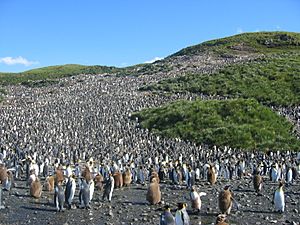
King penguins breed on islands south of 45°S latitude. These are called subantarctic islands. They are found at the northern edge of Antarctica, as well as Tierra del Fuego, the Falkland Islands, and other mild islands in the area. Scientists believe there are about 2.23 million pairs of king penguins, and their numbers are growing.
The biggest groups of breeding penguins are on the Crozet Islands, with about 455,000 pairs. There are also large groups on the Prince Edward Islands (228,000 pairs) and the Kerguelen Islands (240,000–280,000 pairs). Over 100,000 pairs live in the South Georgia area. In the early 1900s, whalers on South Georgia and the Falklands almost wiped out the king penguin population. They ate the birds and their eggs, and burned the oily penguins for fuel. Macquarie Island has about 70,000 pairs.
We don't know exactly where non-breeding king penguins go. Some have been seen far from their usual homes, like in South Africa, Australia, and New Zealand.
Recently, the king penguin population on Île aux Cochons (Pig Island) in the Crozet Archipelago has dropped a lot. It has gone down by almost 90%. This means there are now only about 60,000 breeding pairs. Scientists think this decline might be due to climate change. Their main food source is moving farther away from where the penguins can breed. This could cause penguin numbers to keep falling and make them move to new breeding areas.
In 1936, some king penguins were released in northern Norway. People saw penguins in that area several times in the 1940s. However, there have been no official sightings since 1949.
How King Penguins Live and Behave
In 1971, a zoologist named Gerry Kooyman learned a lot about how penguins find food. He attached special devices to emperor penguins to record their dives. In 1982, he recorded a king penguin diving 235 meters (771 feet) deep. The deepest dive ever recorded for a king penguin is 343 meters (1,125 feet) near the Falkland Islands. The longest time a king penguin has stayed underwater is 552 seconds (over 9 minutes) near the Crozet Islands.
King penguins usually dive 100 to 300 meters (330 to 980 feet) deep during the day. They stay underwater for about five minutes. At night, they dive less than 30 meters (98 feet). Most of their dives are "flat-bottomed." This means the penguin dives to a certain depth and stays there for a while to hunt. This hunting time makes up about half of their total dive time.
King penguins swim at an average speed of 6.5–10 kilometers per hour (4–6 mph). When they dive shallower than 60 meters (200 feet), they swim about 2 km/h (1.2 mph) both down and up. For deeper dives over 150 meters (490 feet), they swim about 5 km/h (3.1 mph) in both directions. King penguins also "porpoise." This is a way they swim fast while jumping out of the water to breathe. On land, they walk with a wobbly gait or slide on their bellies over the ice. This is called "tobogganing." Like all penguins, they cannot fly.
What King Penguins Eat
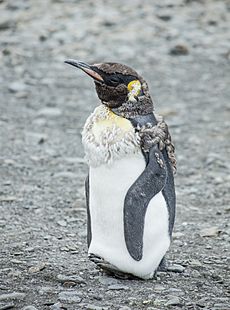
King penguins eat different kinds of small fish, squid, and krill. Fish make up about 80% of their diet. But in winter (July and August), fish are only about 30% of what they eat. Lanternfish are their main fish food. They also eat slender escolar and mackerel icefish. For squid, they eat types like the hooked squid and sevenstar flying squid.
Who Hunts King Penguins
King penguins are hunted by other seabirds and sea mammals:
- Giant petrels eat many king penguin chicks of all sizes and some eggs. They sometimes kill adult king penguins, usually if the adults are sick or hurt. Giant petrels also eat dead adult penguins and chicks.
- Skuas eat smaller chicks and eggs.
- The snowy sheathbill and kelp gull eat dead chicks and eggs that are left alone.
- The leopard seal hunts adult birds and young penguins that have just left the colony.
- Orcas also hunt king penguins.
- Male Antarctic fur seals have been seen chasing, killing, and eating king penguins on the beach.
Reproduction and Life Cycle
King penguins can start breeding when they are three years old. However, most wait until they are about 5 or 6 years old. King penguins usually have one mate each year. They stay with that mate for the whole breeding season. But they often choose a different mate the next year. This is because their breeding cycle is very long.
The king penguin's breeding cycle takes about 14–16 months from when the egg is laid until the chick is ready to go to sea. Because of this long cycle, pairs are usually only successful at raising a chick every two or three years. The breeding season starts in September to November. This is when the birds come back to the colonies to shed their old feathers. Birds that did not breed successfully the year before often arrive earlier. They then go back to sea for about three weeks before returning to land in November or December.
The female penguin lays one pear-shaped white egg. It weighs about 300 grams (⅔ lb). The egg is soft at first, but then it gets harder and turns a pale greenish color. It is about 10 x 7 centimeters (4 x 2.8 inches) in size. Both parents take turns sitting on the egg for about 55 days. Each parent sits for 6–18 days at a time. Like the emperor penguin, the king penguin balances the egg on its feet. It keeps the egg warm in a special "brood pouch" made from its belly skin.
Hatching can take 2–3 days. When the chick hatches, it has only a thin layer of fuzz. It depends completely on its parents for food and warmth. For the first 30–40 days, the young chick stays balanced on its parents' feet, tucked into the brood pouch. During this time, the parents take turns every 3–7 days. One parent guards the chick while the other goes to find food.
As the chick grows, it gets bigger and can keep itself warm better. It can also protect itself from most predators. King penguin chicks are very curious and like to explore. They often gather in groups called a crèche. Only a few adult birds watch over these groups. Most parents leave their chick in these crèches so they can go find food for themselves and their chick. Other penguin species also use this way of sharing care for their young.
By April, the chicks are almost fully grown. They lose weight during the winter months because there is less food. But they gain it back in the spring (September). The young penguins are ready to go to sea in late spring or early summer.
King penguins form very large breeding groups. For example, on South Georgia Island, the colony at Salisbury Plain has over 100,000 breeding pairs. The colony at St. Andrew's Bay has over 100,000 birds. Because their breeding cycle is so long, these colonies always have both adult birds and chicks year-round. King penguins do not build nests. However, they are very protective of their space and keep a pecking distance from other penguins.
King penguins feed their chicks by eating fish, partly digesting it, and then bringing the food back up into the chick's mouth.
Because they are so large, king penguin chicks need 14–16 months before they are ready to go to sea. This is much longer than smaller penguins, which raise their chicks in just one summer when food is easy to find. King penguins plan their mating so that their chicks grow during the hardest season for fishing. This way, by the time the young penguins are old enough to leave their parents, it is summer. Food is plentiful then, and conditions are better for the young to survive alone at sea.
Protecting King Penguins
How Climate Change Affects Them
Scientists believe that 70% of king penguins could disappear in less than eighty years. King penguins are like a warning sign for changes in the ocean. They help us understand how climate change affects sea life, especially in the areas around Antarctica.
King penguins mainly find their food at a place called the Antarctic Convergence. This area provides 80% of their food. Right now, king penguins travel 300–500 kilometers (186–310 miles) over a week to reach this area. But as the ocean gets warmer, this feeding zone could move farther away from their breeding grounds. If carbon pollution keeps rising, king penguins might need to travel an extra 200 kilometers (124 miles) to find food. Nearly half of all king penguin breeding grounds could be lost by the year 2100.
Competition for Food
King penguins are also at risk from large-scale commercial fishing. This fishing could take away their main food source: myctophid fish. In the early 1990s, over 200,000 tons of these fish were caught for human use near South Georgia. If this fishing continues near penguin feeding areas, it could harm the penguins' food supply.
Research and Management Efforts
The Pew Charitable Trust suggests that the Convention for the Conservation of Antarctic Marine Living Resources (CCAMLR) create large, protected ocean areas around Antarctica. They also recommend carefully managing the krill fishery to protect the penguins' food. The CCAMLR is made up of 24 countries (plus the European Union), including the United States and China. These countries have the power to put these protective measures in place.
Scientists also suggest paying special attention to the southernmost breeding locations. This is because water temperatures are expected to rise in the Southern Ocean. They also recommend regularly counting breeding penguins to see how their numbers change over time and with environmental changes.
The king penguin species is currently listed as "Least Concern" by the International Union for Conservation of Nature (IUCN). This means they are not considered highly threatened. Since 2004, the IUCN has reported that the population is large and breeding rates have increased. Adult king penguins have had good survival rates since the 1970s. The stable population is largely due to efforts to protect their nesting places.
To prevent diseases and disturbances, tourism and public access to king penguin breeding sites are very limited. All colonies on the Crozet and Kerguelen Islands are protected by French nature reserves. Penguins on South Georgia also live in a "special protected area." In the Falkland Islands, all wildlife, including the king penguin, is protected by a law from 1999.
King Penguins and Humans
In Zoos and Aquariums
King penguins are considered a "flagship species," meaning they are popular and help raise awareness for conservation. In 1999, there were 176 king penguins in zoos and aquariums in North America. You can see them at many places around the world, like SeaWorld Orlando, Edinburgh Zoo in Scotland, Berlin Zoological Garden in Germany, Melbourne Aquarium in Australia, and Ski Dubai in the United Arab Emirates.
Famous King Penguins
- Brigadier Sir Nils Olav is a king penguin at Edinburgh Zoo. He is the mascot and a high-ranking officer of the Royal Norwegian Guard.
- Misha is a main character in two books by Ukrainian writer Andrey Kurkov.
- The popular character Pondus is a king penguin. You can find his image on many items in stores. Pondus comes from Danish children's books from the 1960s.
- Lala the Penguin became famous online. An Animal Planet show featured him going to a market in Japan to get fish with a special backpack. Lala was accidentally caught by a fisherman. The fisherman and his family helped Lala get better and then adopted him as a pet.
Images for kids
-
Close-up of king penguin chick on South Georgia
See also
In Spanish: Pingüino rey para niños



